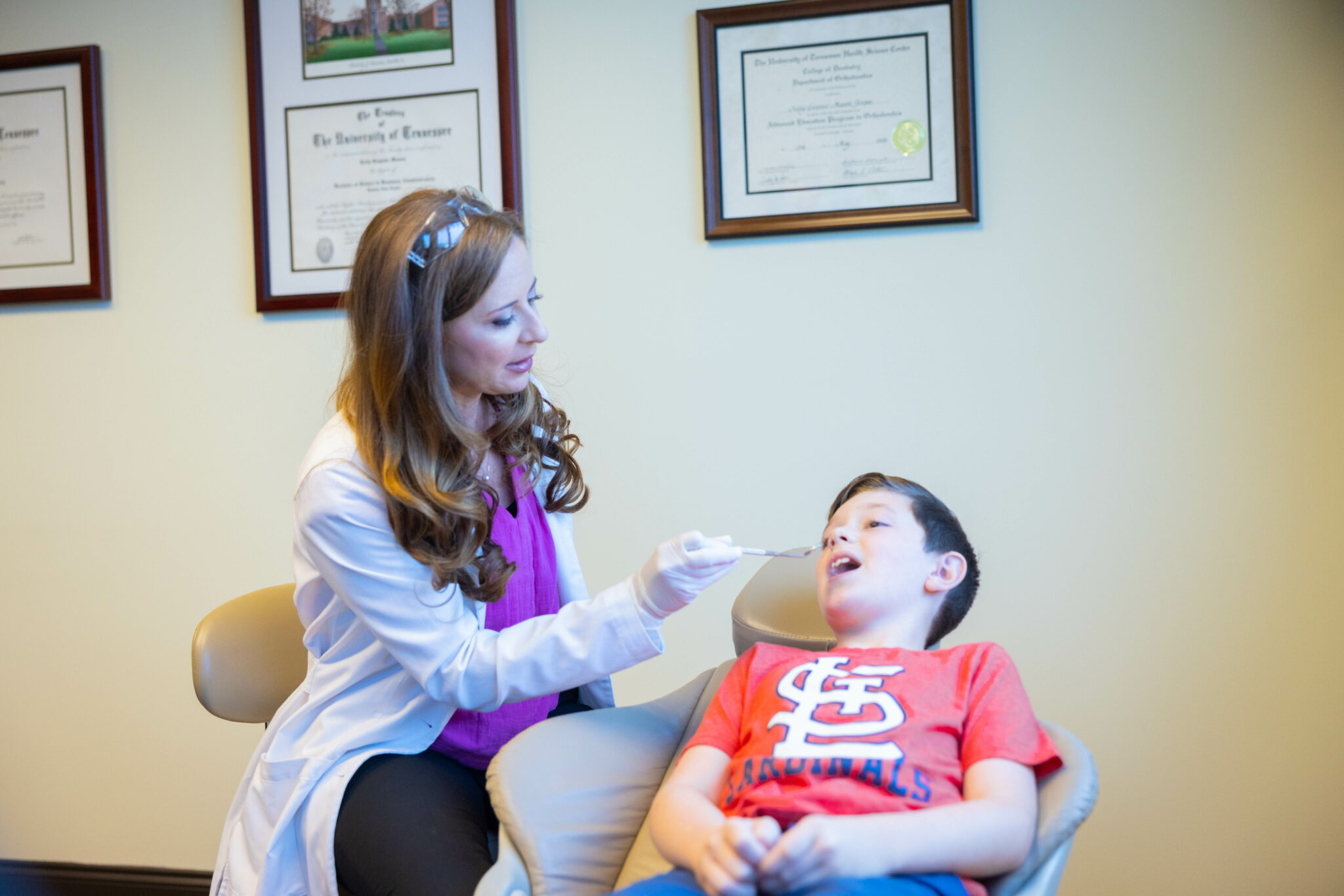When you come to an orthodontist looking for treatment, like Fergus Orthodontics, we want you to know exactly what we’re talking about so you can understand your treatment and have all of your questions answered. We’ve compiled a dental terminology cheat sheet focused on the terms you might hear or read during your orthodontic treatment!
A
American Association of Orthodontics (AAO)
A professional association of orthodontists who have completed years of education beyond graduating dental school. These specialists have completed orthodontic residency at an accredited program. With AAO membership, you can rest assured your doctor is a true orthodontist.
Appliances
Devices used by orthodontists to move teeth or jaws. Appliances can be removable or attached to the teeth throughout treatment.
Archwire
A wire that sits against brackets and is affixed to the crowns of two or more teeth. The archwire is capable of causing or guiding tooth movement.
Attachments
These are used with clear aligners. These bumps or triangles are used to apply extra pressure to certain teeth or areas of the mouth. They are applied to the teeth and are removed once treatment is complete.
B
Band (Orthodontic)
A thin metal ring, usually stainless steel, which serves to secure orthodontic attachments to a tooth. The band, with orthodontic attachments welded or soldered to it, is closely adapted to fit the contours of the tooth and then cemented into place.
Bracket
An orthodontic attachment that is secured to a tooth (either by bonding or banding) for the purpose of engaging an archwire. Brackets can be fabricated from metal, ceramic or plastic.
Bite
This describes how the top teeth and the bottom teeth meet. Ideally, the top teeth meet their corresponding teeth correctly when coming down, which provides optimum biting, chewing, and speaking. It’s called a bad bite or a malocclusion when this does not happen.
Braces
Traditional method of moving teeth using brackets, bands, and archwires. Metal braces are made of stainless steel.
Bridge
This is a method to replace missing teeth by connecting the missing tooth’s replacement with adjacent crowns to hold the new tooth in place. Bridges must be replaced after several years.
Bruxism
The technical term for grinding your teeth, particularly in your sleep. Bruxism can damage teeth by causing excessive tooth wear, cracks, and chips, as well as jaw pain and headaches.
C
Cavities
A hole in a tooth created by tooth decay. Bacteria in plaque weakens the enamel of the tooth until a hole forms. Untreated cavities can make their way to the living tissue, causing severe pain and eventual tooth loss.
Class I Malocclusion
The front teeth are crowded or gapped and have an overbite or an open bite. A Class I malocclusion also can include a crossbite with the back molars or a front crossbite.
Class II Malocclusion
The upper teeth protrude forward, causing the lower teeth to be positioned back too far. The space between the upper and lower teeth is more significant than with a Class I malocclusion
Class III Malocclusion
The lower teeth and jaw are positioned in front of the upper teeth and jaw, often called an underbite.
Ceramic Brackets
Brackets made up of a crystalline material shaded to the color of the tooth that is less visible than traditional metal brackets. They are used in clear braces.
Clear Aligners
Clear acrylic trays that are custom-molded to the patient’s teeth. A series of trays is used to move the teeth into their proper positions. Unlike braces, clear aligners are removable.
Crossbite
A crossbite is when the upper teeth sit opposite where they should on the lower teeth. For example, if the upper molars sit inside the lower molars in the back. A crossbite can be one tooth or several teeth.
Crowding
Misaligned teeth caused by inadequate space for the teeth.
D
Debanding
The removal of cemented orthodontic bands.
Decalcification
White spots created on the teeth by the removal of minerals from the enamel. This happens as a result of poor oral hygiene and the consumption of acidic and sugary foods.
E
Elastics
Tiny rubber bands, usually in a variety of colors, that hold the wire to the brackets in braces.
Enamel
The hard outer shell of the tooth that protects the living tissue inside.
Essix Retainer
A clear acrylic retainer similar to clear aligners. The Essix retainer is used to hold teeth in place after braces.
Expander
A device used to widen the jaw. A palate expander fits in the roof of the mouth and widens the upper jaw, for example.
F
Fixed Appliances
Devices used to widen the jaw or move the teeth that are bonded to the teeth and cannot be removed except by the orthodontist.
G
Gingiva
The tissue that surrounds the teeth consisting of fibrous tissue that is continuous with the periodontal ligament and mucosal covering.
Gingivitis
Early stage gum disease often caused by poor dental hygiene. A buildup of plaque causes inflammation of the gums, causing them to become red and swollen. Gums can bleed during brushing or flossing. Gingivitis can be reversed with treatment and good oral hygiene. Untreated gingivitis can advance to periodontitis.
Gum Disease
Inflammation, infection, and eventual breakdown of the gums as a result of factors such as poor oral hygiene. There are three main stages: gingivitis, periodontitis, and advanced periodontitis.
H
Hawley Retainer
A removable retainer made of acrylic and wires used to hold teeth in place after braces.
Headgear
Generic term for extraoral traction that is attached around the back side of the head to help move the teeth. The wires attach to the braces, and the straps pull the teeth back.
Herbst Appliance
Fixed or removable appliance designed commonly for overbite problems and more.
I
Imaging
Using scanning technology to acquire images of the teeth and jaws, either digitally or through x-rays.
Impaction
A tooth that has not erupted through the gums and is embedded in the jaw. It could also be partially erupted and still be considered impacted.
Implant
A metal replacement embedded into the jaw to hold a crown. An implant replaces a missing tooth so the patient can bite, chew, and speak properly. An implant can be one tooth or several teeth.
Interproximal Brush
A small, round brush used to clean between teeth. This brush makes it easier to get around wires and brackets and floss teeth with braces better. It can also be used to clean around the wires and brackets themselves.
L
Lingual
Of or pertaining to the tongue. A term used to describe surfaces and directions toward the tongue.
Lingual Braces
Braces that are affixed inside the teeth on the tongue side. These braces are mostly hidden from view.
Lingual Retainer
Also known as a permanent retainer, this is a wire that is bonded to the inside of the front teeth on the tongue side. This retainer is not removable.
M
Malocclusion
Also known as a “bad bite,” this is when the upper teeth and lower teeth don’t line up properly when the patient bites down.
Mandible
The lower jaw.
Maxillary
The upper jaw. May be used to describe teeth, dental restorations, orthodontic appliances or facial structures.
Mouthguard
A device used to protect the teeth from impact, such as during sports. Mouthguards are important for braces patients because the braces could cause further damage from an impact on the mouth’s soft tissue.
N
Nightguard
An appliance similar to a mouthguard worn at night to prevent damage from issues such as bruxism.
O
Open Bite
A malocclusion where the front upper teeth do not touch the lower teeth. Often, the upper teeth are angled outward. A posterior open bite means the back molars don’t touch when the front teeth are closed.
Orthodontist
A dental specialist who has completed an advanced post-doctoral course, accredited by the American Dental Association, of at least two academic years in the special area of orthodontics.
Orthodontics
A specialty area of dentistry that specializes in the movement of teeth and the correction of malocclusions.
Orthognathic Surgery
Surgery to alter relationships of teeth and/or supporting bones, usually accomplished in conjunction with orthodontic therapy.
Overbite
The upper front teeth overlap the lower teeth when the back teeth are closed.
P
Periodontal Disease
A chronic infection of the gums resulting from poor oral hygiene and the buildup of plaque. Gum inflammation eventually develops into infection and can result in tooth loss if left untreated.
Periodontitis
A more serious form of gum disease and the next stage after gingivitis. The bacteria destroys the tissue and bone that holds teeth in place. Pockets of space between the gums and teeth form, which can lead to more bacteria getting into the gums. Without treatment, the gums and jaw will break down and become infected. This can lead to advanced periodontitis, with infection and tooth loss as the result.
Permanent Teeth
The second set of teeth that erupt after the primary (baby) teeth fall out. These are the teeth we have for the rest of our lives once the baby teeth are gone.
Phase One (Phase I) and Phase Two (Phase II) Treatment
Usually performed with younger patients, the first phase occurs with many of the baby teeth still in place. This usually involves placing appliances in the child’s mouth to prepare the child for braces later. This can involve widening the jaw to allow enough space for the teeth or installing devices to end habits such as tongue thrusting or thumbsucking. In Phase II, braces are placed on the teeth once most of the permanent teeth are in. Because of the preparation in Phase I, braces treatment in Phase II is usually easier.
Plaque
A sticky film comprised of bacteria and food residue that sticks to the teeth. Plaque and sugars form acids that can decay tooth enamel and cause cavities. Plaque can also cause gum disease. Plaque can be removed through proper and regular brushing and flossing.
Primary Teeth
Also called baby teeth, deciduous teeth, or milk teeth, these are the first set of teeth in humans.
R
Radiograph
A permanent image, typically on film, produced by ionizing radiation. Sometimes called an X-ray after the most common source of image-producing radiation.
Retainer
Any orthodontic appliance, fixed or removable, used to maintain the position of the teeth following corrective treatment.
Retention
The passive treatment period following active orthodontic correction during which retaining appliances may be used.
Rubber Bands
Larger than elastics, rubber bands help apply extra pressure to move the teeth in certain directions. They often stretch from the upper jaw to the lower jaw.
S
Separators/Spacers
A small, elastic o-ring or wire loop placed between teeth to add space so bands can be placed on the teeth. These are usually placed between molars for braces.
Self-Ligating Braces
Modern metal braces that don’t use elastics to hold the archwire against the brackets. Self-ligating braces are faster and more comfortable than traditional braces.
T
Tongue Crib
An appliance placed in the roof of the mouth to help stop a patient from thrusting their tongue against their teeth or from sucking their thumb.
Tongue Thrust
A habit where the person pushes their tongue against their teeth while swallowing. The force can move the teeth forward.
U
Underbite
A malocclusion where the lower front teeth sit in front of the upper front teeth. It’s also called a Class III malocclusion.
V
Veneers
A thin shell that is the color of teeth that is bonded to the front of teeth to cover up flaws such as discoloration, chips, cracks, or breaks. Veneers can be placed after orthodontic treatment to repair any malocclusions.
W
Wax
Also called braces wax or dental wax, this is a non-toxic, special type of wax used to cover areas of braces that are irritating the soft tissue.









